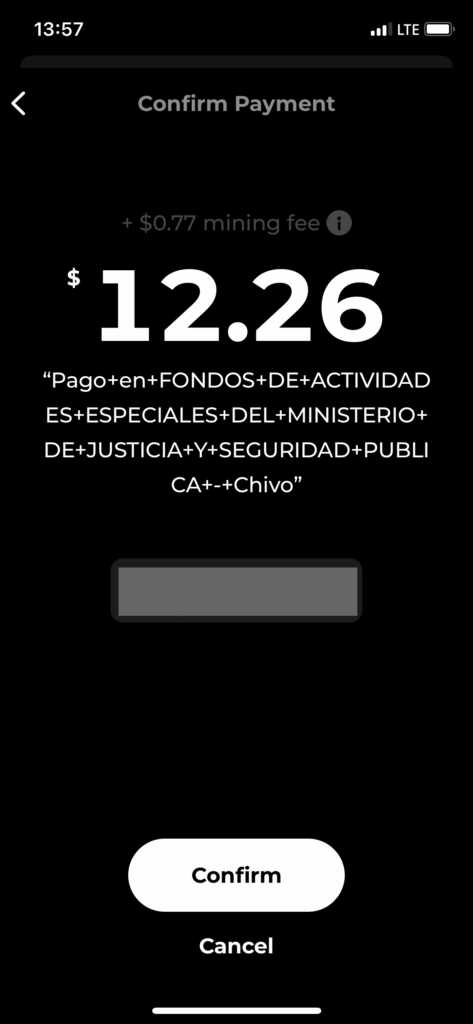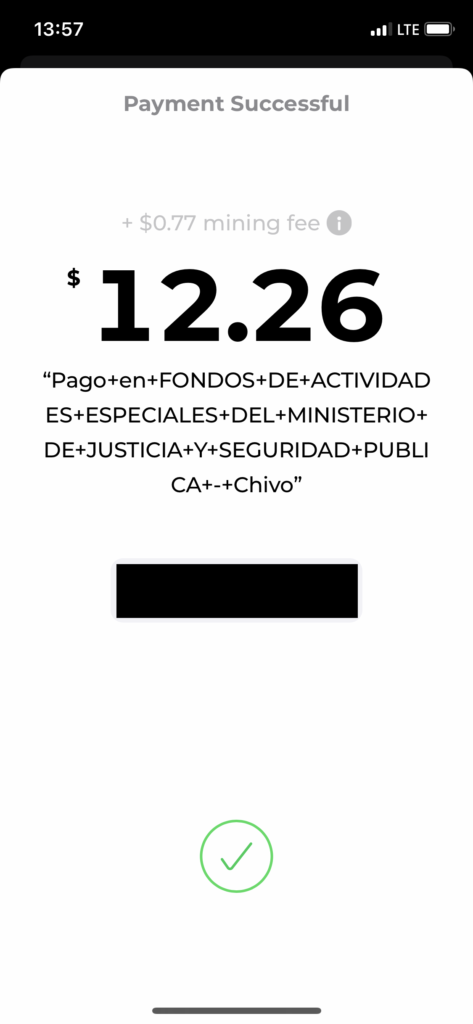I have a lot to write about on my first day. This is going to come across more as chronological bullet points and not well thought-out prose.
Aueropuerto
I was hungry upon landing, so I first opted for lunch at a restaurant in the airport. The atmosphere felt very familiar to me, like a craft brewery in the USA, but with Latin American food; good way to transition to a new culture. I had Uruguayan sausage. Very good.

I asked if I could pay with Bitcoin, and they said no, so I opted for credit card.
Inmigración
I followed the signs for immigration and customs. The guards directed me to a payment counter. Taped to the glass at the payment desk was something similar to BitBoy’s “Bitcoin Accepted Here” sign, but home-made in Microsoft Word. (Also a sign with pictograms for cash, credit cards, and Bitcoin).
When I asked to pay the fee of $12 in Bitcoin, the woman generated an invoice with me. I can not remember the device; it may have been a tablet.
My first attempt to pay with Zeus failed — I don’t entirely recall the error message I received, as I was more focused on navigating my with through Customs.
I whipped out Strike so that I would not hold up any lines. That worked instantly. She printed out a Chivo receipt for me.

Sending payment 
Payment success
Drive
I took an Uber from the airport to my lodgings. Due to bad traffic, my driver took us on a detour through the countryside where we passed by small farm houses and fields of crops. Concrete blocks are a popular building material here.
Check-in
When I checked in to my lodgings, I asked if I could pay in Bitcoin when it was time to pay. The man behind the counter turned to another employee, perhaps the manager. She whipped out a phone with Wallet of Satoshi and took my payment that way.
We chatted for a few minutes about Bitcoin adoption in her country. She described herself as “very pro-Bitcoin”. She said she was nervous when she first heard about it, but once somebody “took 3 minutes” to show her how to use a wallet, she was onboard with the idea. She also has Binance wallet and Strike, though she doesn’t like Strike as much.
I asked her how other people in the country felt. She said that she feels the people who are opposed to Bitcoin do not understand it. She also pointed out that there are many people who do not have access to smartphones in the country; I said something like “that must be scary for them, if they feel like the rest of the country is adopting this new thing without them and leaving them behind” and she agreed.
Farmacia
I went to two local pharmacies to buy some stuff — neither place would except Bitcoin.
Mi Primer Bitcoin Meetup

I attended a meetup group put together by IBEX Mercado and Mi Primer Bitcoin at Cadejo Brewing.
MPB is a grassroots group in San Salvador that helps teach people how to use Bitcoin wallet. Let me re-iterate that: this is not a technical discussion group; they are trying to teach people how to use Bitcoin wallets in their daily lives. I think that’s very good.
Fear, Uncertainty, Politics, Bad Memories
I asked some local people about how other people in El Salvador feel about this technology. They said that many people do not understand how it works. They are afraid of the value of their bitcoin changing. They said there are many people who are uneducated or who do not known smartphones.
Additionally, people’s perceptions of Bitcoin sometimes become intertwined with their feelings regarding Nayib Bukele; some people have a difficult time separating their opinions about Bitcoin from their opinions about Nayib Bukele.
Dollarization
I spoke with someone who lived in El Salvador when the country transitioned from the colón to the dólar (dollar).
The exchange rate was difficult for many people to navigate. The conversion was something like 1 dollar = 8.75 colóns. They told me that if you were going to do a large purchase (maybe a car), then you would pull out a calculator and convert the colón to dollar properly.
However, this wasn’t feasible for owners of small shops who dealt in small transactions (convenience store selling drinks). Shop owners would simply round the colon price to a lower dollar price. As a result, this inadvertently caused price inflation for many goods.
Also, people were told that colons and dollars would both be maintained as legal tender moving forward. That ended up not being the case; the colon was eventually phased out.
For many people who lived in SV during that time period, this brings back bad memories. It also raises the fear for them that the government could take the dollar out of circulation and force everyone to switch to bitcoin. While I personally find this unlikely, the fear is there and it is based off prior example.
Handling dollar to bitcoin conversion with good UX
One person pointed out to me something that they think Chivo does well, which is show USD and BTC balances side by side. This helps people to easily understand that they can hold both dollars and bitcoin.
The fact that bitcoin is digitally native money makes it so that people will not have to worry about complicated conversions like they did with the colon and the dollar; since bitcoin payments are almost always going to be initiated with a piece of software, the dollar conversion can be handled automatically!
Other Anecdotes
- A Salvadoran man recounted visiting several cities in the US and being shocked that no stores accepted bitcoin.
- Mi Primer Bitcoin is recommending Muun to many people for it’s easy UX.
- One man described how at the Starbucks, there were 3 tablets setup: one for Chivo and then two other wallets. I asked why all 3 wallets couldn’t be used on one tablet. His guess was that it was easier on the stuff. He told me that for many employees, it might be their first time using a tablet, or that they may not have a tablet at home.
Chivo Issues
I have been hearing good things about Chivo in regard to ease of use. However, some have had issues when sending from a non-custodial LN wallet to Chivo.
One man described sending from BlueWallet (LNDHub implementation) to Chivo. His funds are no longer in his wallet, but the Chivo wallet never received the funds.
My guess: did a node somewhere in the path go offline? Is this a stuck HTLC? I’m not sure how to recommend one troubleshoot this issue; I imagine that an issue like this would need to be troubleshooted by looking at some more complicated TX details on the LNDHub.
Failed payments present a huge problem, IMO, particularly like this where people aren’t sure what to do.
Camera Issues
At the end of the night, a table of four of us closed our tabs. My LN payment with Zeus failed, but it probably just had trouble finding a path. No big deal. BlueWallet worked.
2 members of our table had Android wallets. Their wallets could not seem to focus on the QR code for the LN invoice from the waiter (who used IBEX Mercado). Interestingly enough, their phones could focus on QR codes using other camera apps.
Is this an issue with open source camera libraries? Need to investigate further. Overall, a waiter having to watch a table of four people wrestle with their phones to get a lightning payment to work is not a good look for Bitcoin.
It was a good first day in El Salvador. That’s a lot of detail heavy stuff. I’ll try to explore more topics in-depth in the coming weeks.
